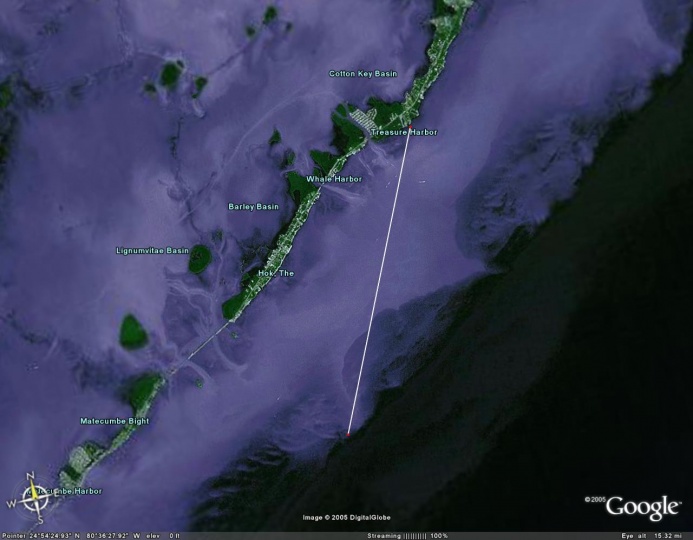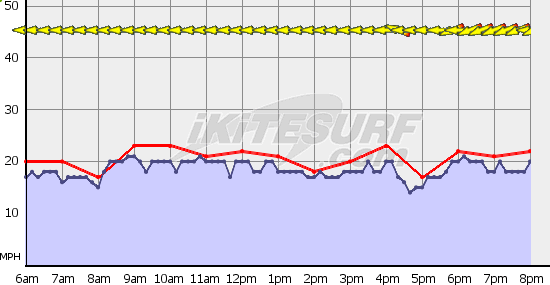With the Florida to Bahamas race coming up it seems appropriate to start a thread dealing with distance kiteboarding runs. Of course the competitors should gain a great deal of insight from training distant runs.
Last weekend I headed down to Islamorada, FL for some unseasonable July wind. The forecast was for 15 to 20 kts. side onshore and minimal storms, a good thing this time of year.
I headed off for some short roundtrip runs (roundwinders) to Alligator Light, about five miles offshore and over eight miles south of my launch area. It was not quite a beam reach on the way out and I had to tack backup wind to return to the launch with the wind out of the east. So, I would guess I added a few miles to the run for a total of about 20 miles for each trip. The winds for the Saturday run were a bit light and a bit stronger for the repeat trip on Sunday.

I did both trips with a 13 m kite and a long LWD 181 cm twin tip. The first day out of necessity given the lighter conditions and the second day because I thought it would allow me to ride a bit closer to the wind when I tacked back upwind.

The first day I was able to head more or less directly to the light starting at about noon however I headed to a point close to upwind of the target should the winds die a bit. I started riding at about 10 am each day for a warmup run. I had to sinusoid fairly frequently on the way out and back. The waves weren't that large on this day. The outbound trip when fairly quickly despite the slower speed and I was grateful to have such a large board. I am not sure that I would have made it to the light on something smaller and am skeptical that I would have made it back without walking several miles upwind using a shorter board.

Alligator Lighthouse at the halfway point.
I came in closer to shore in calmer water about two and a half miles south of my launch. I ended up doing a dozen or more tacks to work back upwind to the launch. I had to sinusoid almost continuously on the way back. The calmer water helped with the tacking effort. The roundtrip took about 2 1/2 hours.

The second day it was a bit stronger and I still decided to change from a smaller 130 cm board that I had been riding to the longer board hoping it would help me tack back. I thought the outbound trip that started at about 12:30 would be faster than the day before. This was true for sections but as I was running a bit off the wind, I had to sinusoid the kite at times as opposed to locking it in and running on an easy beam reach. This would have me ending up a few miles north of the light. Once I got a few miles offshore it became fairly rough with 2 to 4 foot seas and some chop. The longer board made taking the chop a bit more difficult. There was some foot discomfort as the long board had some old bindings that could be changed out for something more comfortable. I carried a camel pak on both days and each day I ran out of water in the 90 degree sunny conditions about an hour before returning to the launch. Navigation was a bit tricky given the low coastline and haze present that day. The light would appear and dissappear on the horizion near the start of the run. It was easier to pick a point in the fairly rapidly moving clouds to steer on as opposed to squint at the faint light on the horizon. I reversed heading twice just to better memorize what the land marks would look like for the return run from 8 miles to the south.
NOTE: memorizing shore marks can be an important step sometimes. Last month down in Aruba I tacked upwind and out a narrow gap in the reef that protected the windward shore bay I was riding in. The surf was running 10 to 12 feet. I assumed returning from offshore the water might look the same across the bay leading me to attempt to come in over shallow reef in pounding surf, ouch! So, I reversed course to memorize some shore points bounding the north and south sides of the channel through the reef before heading well offshore. Anyway, back to the Keys, the second trip took about 2 hours. Again, riding upwind in the calmer water nearshore was much easier than in the choppy stuff.
A good warmup and warm down helped. Acutally covering forty miles in two days wasn't that demanding and allowed enough energy for several hour sessions each day prior to and upon return to the launch. Selecting gear to reduce unnecessary exertion could be an important component of stacking the deck for going the distance.
What other ideas and experiences do folks have on distance runs?
